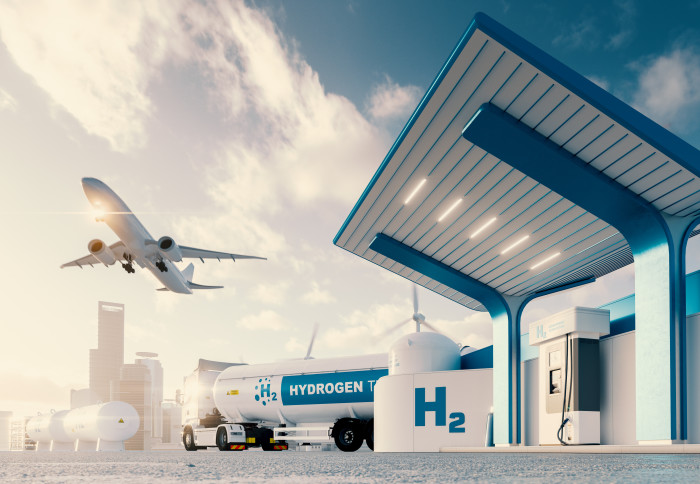Since end of the last Century, many efforts are engaged against global warming and for an energy transition.
As 24% of global CO2 emissions from fuel combustion is from logistic sector, so an ecological transition was mobilized to reduce this impact on different transportation ways, cars, buses, train, marine, space and aeronautics.
Hydrogen was selected to achieve this carbon neutrality goal.
Hydrogen is an established, versatile, and easy-to-produce energy source (from Electrolysis process) and environmental friendly: Zero harmful emissions, only water emissions.
Advantage for logistic
Fast refueling: Recharge in less than 5 minutes allowing a range of more than 600 km with Competitive cost: The fuel cost will be reduced with 20%
Environmental issue: improvements in air quality, especially around urban centers, so reducing mortality and morbidity due to air pollution in addition of limit noise levels in dense areas
Regarding safety and in case of accident: H2 can be a safer fuel than e.g. gasoline or methanol: because of its high buoyancy it does not accumulate around leak points, reducing the risk of explosions an H2 fire causes fewer toxic emissions and less severe radiant heat damage.
Disadvantage for logistic
Hydrogen must be compressed, liquefied, or chemically combined to provide same equivalent energy than natural gas ( 3.2 times H2 volume liquefied)
Additional H2 in the atmosphere due to leakage
Lacking large scale infrastructure
Reduced number of Hydrogen refueling stations
Costs of components still too high (are decreasing)
Hydrogen also from fossil origin (steam methane reforming (SMR))
Car transportation
It’s called FCEV Fuel Cell Electrical Vehicles or ZEV Zero Emission Vehicles or Hydrogen Vehicles.
The main components are a Fuel Tank – Hydrogen gas is stored in carbon-fiber reinforced tanks, Fuel Cell Stack –to generate electricity and power the electric motor, Electric Motor, and Battery – Captures energy from regenerative braking.
As performance, Hydrogen fuel cell cars are quiet, very energy efficient, produce no emissions and have equivalent range and performance to gasoline counterparts. Drivers identify range, refueling time, emissions, power and performance as valuable vehicle characteristics
Fuel cell cars can carry enough hydrogen fuel for 300-400 miles of range and their tanks can be refilled as quickly as that of a standard car’s gas tank.
Buses transportation
Fuel cell electric buses have the longest range (> 300 km) / no need to return to the depot during daily service, the hydrogen tanks are usually stored on the roof of the bus, while the fuel cell and electric engine are located at the back of the bus.
Shipping:
In July 2021, The world’s first hydrogen powered vessel Hydra has been delivered by Shipyard Westcon Group to ferry operator Norled, with Car capacity: 80 units, trailer capacity: 10 units and Passenger capacity: 290 pax
Rail way
Alstom first presented the Coradia iLint to the public at InnoTrans Berlin in 2016 and in 2018 the Coradia iLint received approval for passenger operation in Germany. Since then, the first two pre-series trains have already covered more than 200,000 kilometres of regular passenger service. Starting in 2022, Alstom will begin delivering the first of a total of 41 Coradia iLint series trains ordered in Germany.
Air traffic
Hydrogen as an aircraft fuel struggles with aviation limitations of weight and volume. Fuel cells are heavy with the required power. The turbines could burn hydrogen gas directly, but then the property of hydrogen strikes that it would be power-dense in terms of mass, but not in terms of volume: an H2 tank would have to be 3.4 times the size of a kerosene tank. Airbus’ H2 long-haul concept presented in 2020 therefore stores the hydrogen behind the (correspondingly reduced) passenger cabin in the fuselage.
California Environmental Goals Case’s
Established ZEV regulation and targeting in 2035 –100% in-state passenger vehicle sales are ZEV, and 100% new bus purchases ZEV by 2029, and100% of all operating buses ZEV by 2040 For advanced clean trucks, manufacturing starting in2024 and 100% sales by 2045.
For this transition, hydrogen refueling station will be 200 stations by 2025 and 1000 station by 2030.
Cost approach, by 2016: state put up 70% of the capital cost and by 2020 industry is bringing ~70% capital cost.

Hydrogen fuel cell China Case’s
Established ZEV targeting is 50000 in 2025 –20% buses and trucks, and 80% new passenger vehicles cars.
For this transition, hydrogen refueling station will be more than 300 stations by 2025
Lessons learned
-Global market has launched
-Hydrogen can be stored, centralized or decentralize
-Three key California lessons;
- Leadership is crucial
- Shared vision and plans are fundamental
- Policy & investment commitments move markets
-Strategic alliances with industry, governments & knowledge institutes
-Profitability opportunities in vehicle, fuel and infrastructure
-Scale is the key to a sustainable market
BY Monia SAMMARI